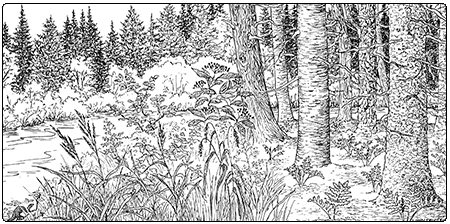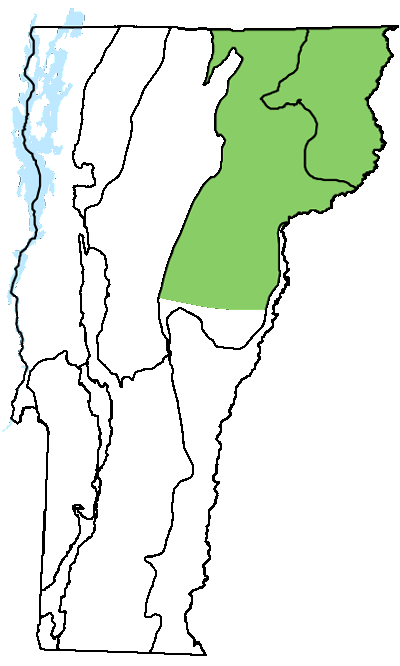Ecology and Physical Setting
This natural community is found along small and medium-sized streams and rivers in northeastern Vermont. Cold air drainage makes these stream valleys and basins some of the coldest places in the state, and results in a distinctly boreal flora. These floodplains are usually flooded for a shorter duration, and less frequently, than floodplain forests along larger rivers. Ice jams and ice scour are recurring disturbances that help maintain openings dominated by herbs and shrubs. Large chunks of ice deposited in the floodplain crush and kill woody vegetation. Unlike floodplain forests on large rivers, which are almost always nutrient enriched, soil enrichment in this community usually reflects the underlying bedrock. The alluvial soils have a sandy to silty loam texture, with little or no accumulation of surface organic matter. This community is generally considered a wetland.
Along low-gradient, medium-sized streams and rivers, Boreal Floodplain Forests are often found as part of a mosaic with other wetland types, such as Alluvial Shrub Swamps, Alder Swamps, and Northern White Cedar Swamps.
Vegetation

spruce-fir forests.
Boreal Floodplain Forests are variable in structure and species composition. The canopy varies from quite open to fully closed. Balsam fir and white spruce are characteristic species. Other typical tree species include black ash, black cherry, northern white cedar, and balsam poplar. Silver maple may be present occasionally, but it is generally not abundant. When the canopy is sparse, the shrub layer can be very dense. Speckled alder and beaked hazelnut are common shrub species. Ostrich fern and sensitive fern often dominate the herbaceous layer, but other species such as bluejoint grass and virgin’s bower can be abundant.
Wildlife Habitat
As with other riparian areas, Boreal Floodplain Forests support riparian obligate species like mink, otter, and wood turtle, while also attracting many other wildlife species. The patchy canopy supports ruffed grouse and American woodcock, species also found in young upland forest. Woodcock forage for invertebrates in the moist, loose soils. The softwood trees and cold climates of these floodplain forests provide breeding habitat for Canada warbler and several rare and uncommon birds, including yellow-bellied flycatcher, black-backed woodpecker, Canada jay, and rusty blackbird. Ebony jewelwing is a damselfly associated with river shorelines that also makes use of the shady margins of floodplain forests.
Successional Trends
Ongoing disturbance from flooding and ice-scour helps maintain early-and mid-successional species like balsam fir, black cherry, and white spruce. The dominance of any of these species may also reflect past land clearing.
Related Communities
- Silver Maple-Ostrich Fern Floodplain Forest is found along moderate-gradient rivers and on the levees of lower-gradient, large rivers in warmer regions. It has a tall canopy dominated by silver maple, an understory dominated by ostrich fern, and usually very few native shrubs. Alluvial soils are generally sandy.
- Silver Maple-Sensitive Fern Floodplain Forest is found in warmer regions along large, low-gradient rivers, in the wider floodplain behind the levee. It is characterized by silver maple, a dense carpet of sensitive fern, sparse shrub cover, and silty soils.
- Alluvial Shrub Swamp is similar in shrub and herb composition to open-canopy Boreal Floodplain Forests, and these two communities can intergrade. Alluvial Shrub Swamps have less than 25 percent tree cover.
Conservation Status and Management Considerations
This is a rare natural community type in Vermont, and its full distribution is not known. It is likely that many examples in Vermont were once cleared for agriculture or have a history of timber harvesting, so restoration may be needed. A number of examples are protected on conserved land.
Distribution/Abundance
Boreal Floodplain Forest is a rare natural community type in Vermont and is known only from the Northern Vermont Piedmont and Northeastern Highlands. Examples may occur in the Northern Green Mountains. Similar floodplain forests are found in northern New Hampshire, Maine, and Québec.
Characteristic Plants
Trees
Abundant Species
Balsam fir – Abies balsamea
Black ash – Fraxinus nigra
Black cherry – Prunus serotina
White spruce – Picea glauca
Yellow birch – Betula alleghaniensis
Northern white cedar – Thuja occidentalis
Balsam poplar – Populus balsamifera
Occasional to Locally Abundant Species
Silver maple – Acer saccharinum
Red maple – Acer rubrum
Shrubs and Vines
Occasional to Locally Abundant Species
Speckled alder – Alnus incana
Beaked hazelnut – Corylus cornuta
Wild raisin – Viburnum nudum var.cassinoides
Dwarf raspberry – Rubus pubescens
Virgin’s bower – Clematis virginiana
Herbs
Abundant Species
Ostrich fern – Matteuccia struthiopteris
Sensitive fern – Onoclea sensibilis
Occasional to Locally Abundant Species
Bladder sedge – Carex intumescens
Bluejoint grass – Calamagrostis canadensis
Bearded shorthusk – Brachyelytrum aristosum
Rough-stemmed goldenrod – Solidago rugosa
Sarsaparilla – Aralia nudicaulis
Rare and Uncommon Plants
Swamp thistle – Cirsium muticum
Satiny willow – Salix pellita
Wiegand’s wild rye – Elymus wiegandii
Associated Animals
River otter – Lontra canadensis
Mink – Neovison vison
Raccoon – Procyon lotor
American beaver – Castor canadensis
Ruffed grouse – Bonasa umbellus
American woodcock – Scolopax minor
Canada warbler – Cardellina canadensis
Yellow warbler – Setophaga petechia
Wood duck – Aix sponsa
Hooded merganser – Lophodytes cucullatus
Common merganser – Mergus merganser
Ebony jewelwing – Calopteryx maculata
Rare and Uncommon Animals
Wood turtle – Glyptemys insculpta
Yellow-bellied flycatcher – Empidonax laviventris
Black-backed woodpecker – Picoides arcticus
Spruce grouse – Falcipennis canadensis
Canada jay – Perisoreus canadensis
Rusty blackbird – Euphagus carolinus
Red crossbill – Loxia curvirostra
Osprey – Pandion haliaetus
Places to Visit
Victory Basin Wildlife Management Area, Victory, Vermont Fish and Wildlife Department (VFWD)
Lower Barton River Wetlands, South Bay Wildlife Management Area, Coventry, VFWD
Nulhegan River, Conte National Wildlife Refuge, Brunswick and Ferdinand, US Fish and Wildlife Service
Steam Mill Brook Wildlife Management Area, VFWD
